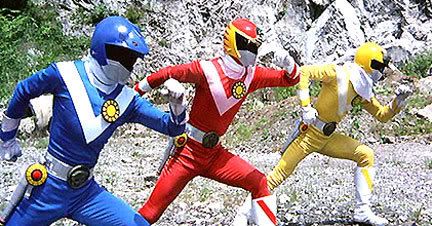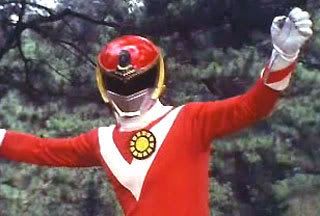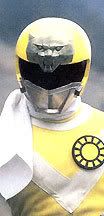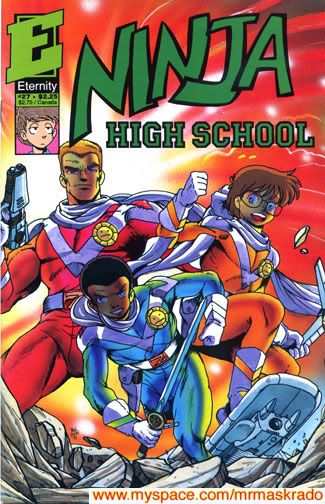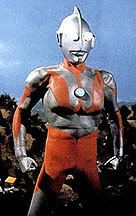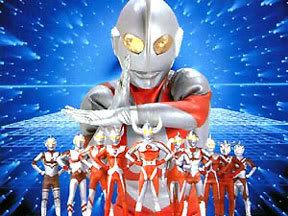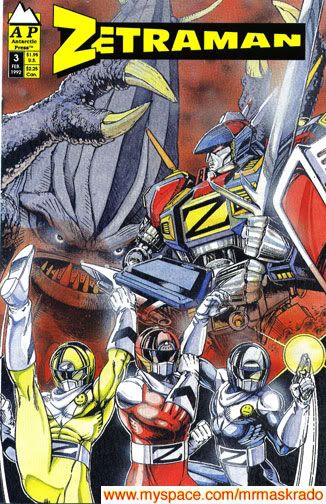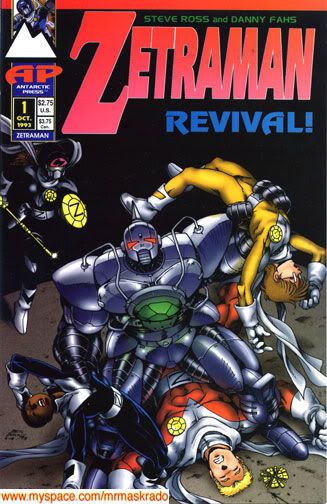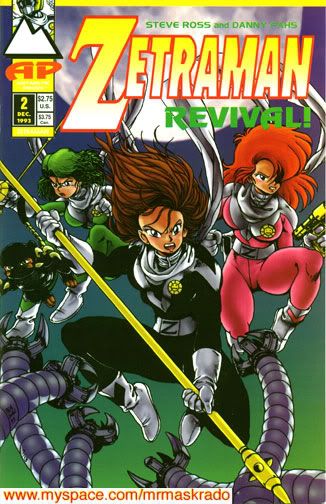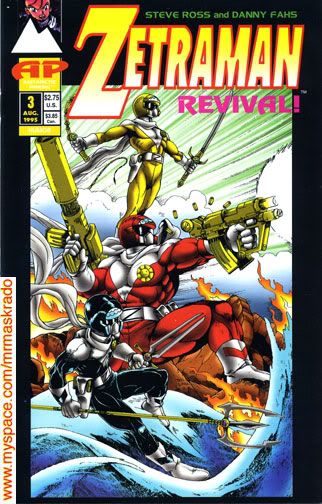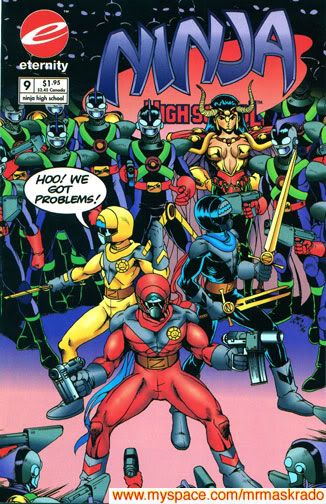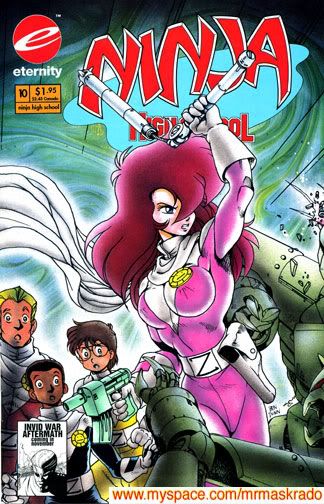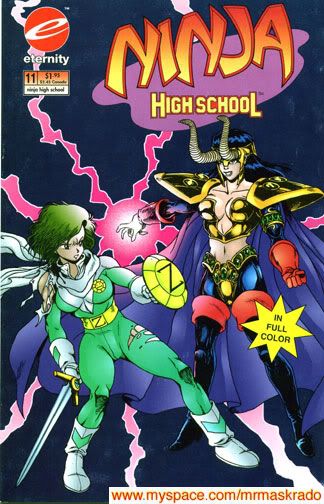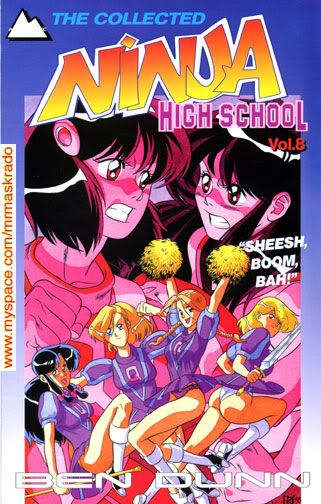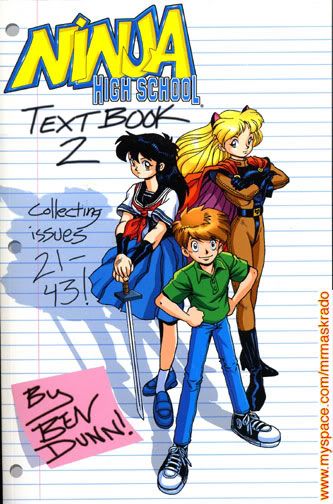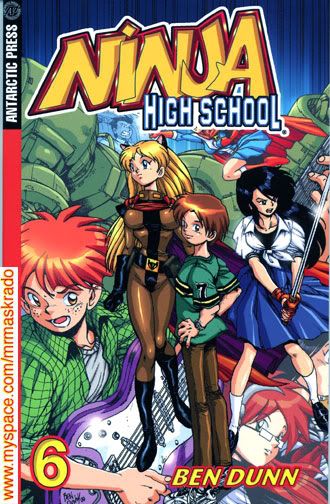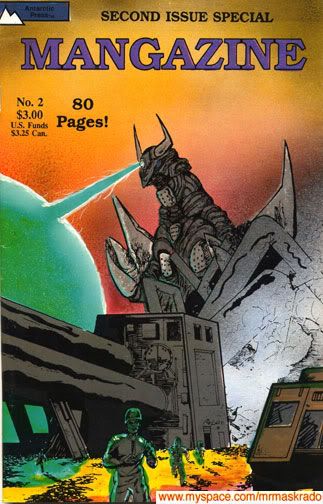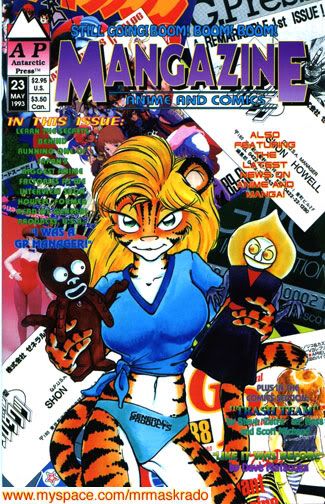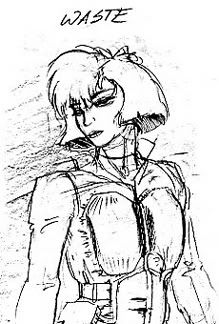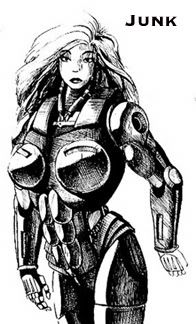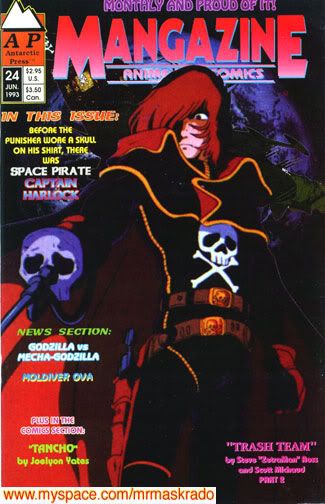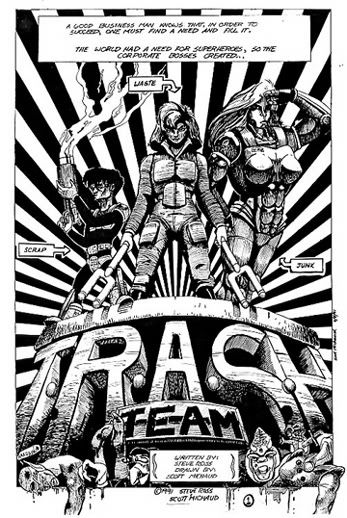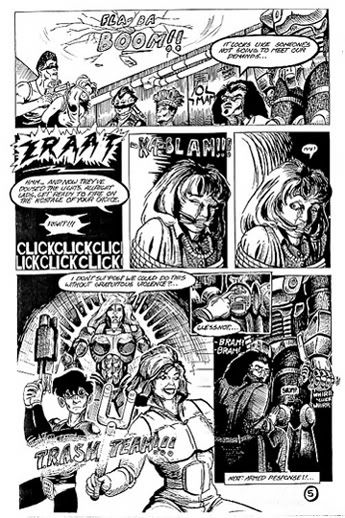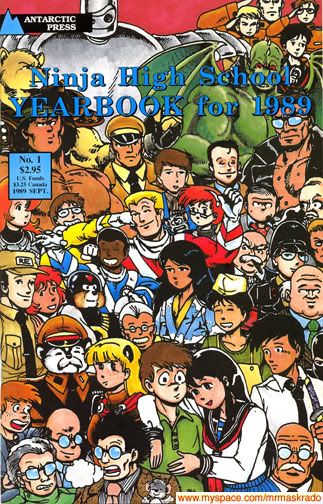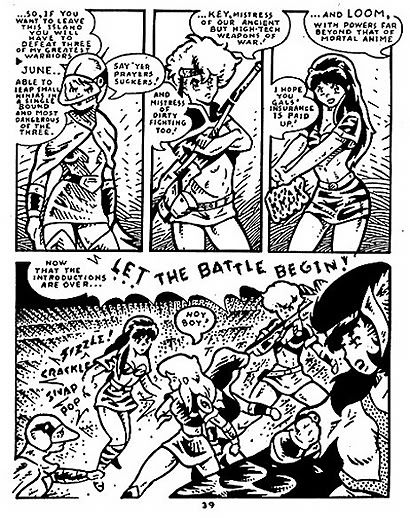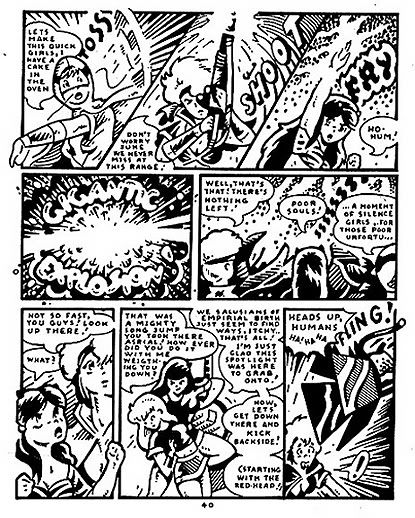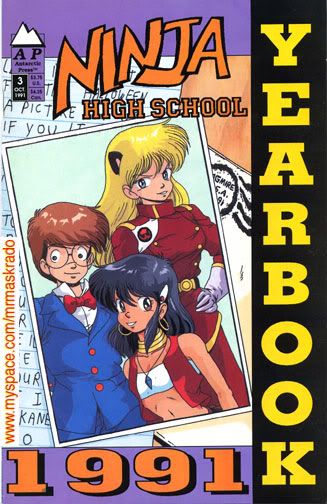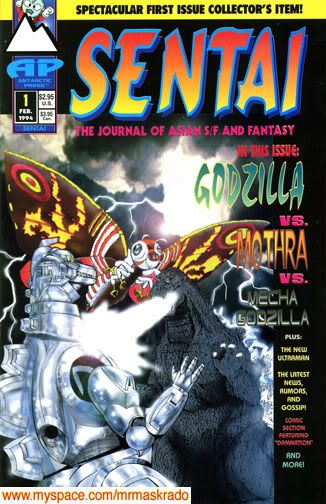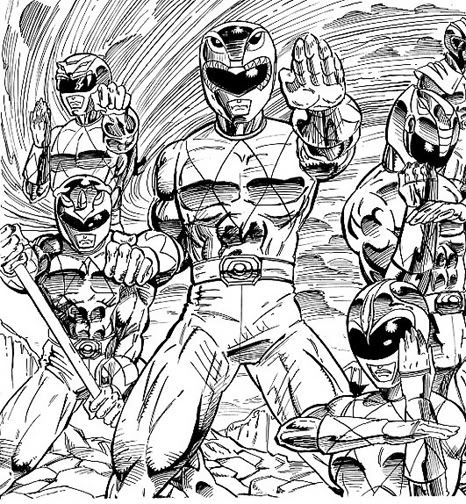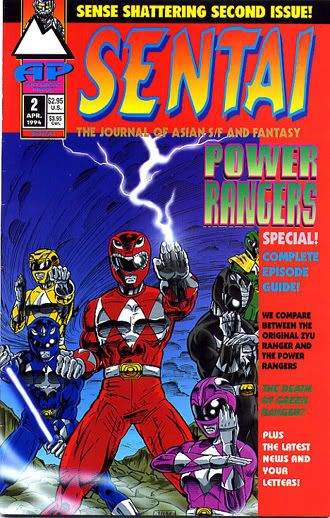We Are ZETRAMAN!
"Zetraman was of my earlier comic book scripts,
but it still holds up."
--Steve Ross
"Zetraman made me laugh out loud."
--Richard Sakai (Producer, "The Simpsons")
"The world can be saved by steam!"
--Professor Steamhead
"Steam On!"
--Zetraman
Zetraman first appeared in Ninja High School #07, created by Ben Dunn and published by Eternity Comics (which later became a part of Marvel Comics).
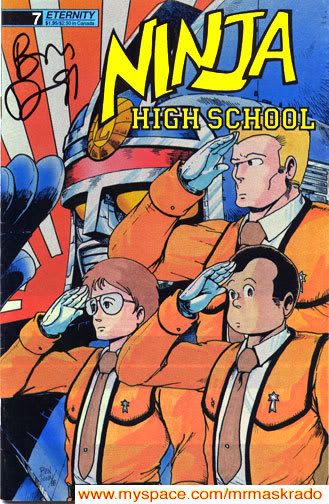
(This is one of the few Zetraman stories I didn't write.
The cover was signed by Ben Dunn.)
Zetraman began as a three-man team, even though the word "Zetraman" is singular. (A tribute to Japanese attempts at "Engrish.")
The initial line-up was:
MIKEY (Zetra Blue):
African-American, unofficial team leader,
"the intellectual one"; water powers
HOWARD (Zetra Red):
Tall, blonde, and Nordic; looks for the simplest solution;
"the strong, silent type"; Earth powers
PHRANK (Zetra Yellow) :
Possibly Hispanic, wears glasses; a bit of a lech;
"the comic relief"; wind powers (usually gas-related)
Ben Dunn and I are big fans of Japanese live action superhero shows. We loved the Super Sentai series long before they were re-edited with American-shot footage, and made their American debut as the Power Rangers.
Ben especially liked a show called Sun Vulcan. Zetraman's "Have a (Zetra) Day" badges are a parody of the ones worn by the Sun Vulcan team.
(Limited edition replicas of the Zetra Badges were manufactured and sold by Antarctic Press. Now they're rare collector's items!)
Since Ben and I were on the same Super Sentai page, he let me write the next Zetraman story, which appeared in Ninja High School #27.
In "Three Zetramen and a Baby," I fleshed out Mikey, Howard, and Phrank's characters, since their first appearance was little more than a series of funny gags.
I also introduced Dertoza and Leiola: brother-and-sister villains who have since become recurring characters in the Ninja High School series.
The story also features UltraBaby.
UltraBaby's origin is a parody of the first Superman movie.
UltraBaby is a cute, "super-deformed" take off of the iconic Japanese superhero Ultraman.
A 3-issue Zetraman miniseries followed shortly after NHS #27 was published.
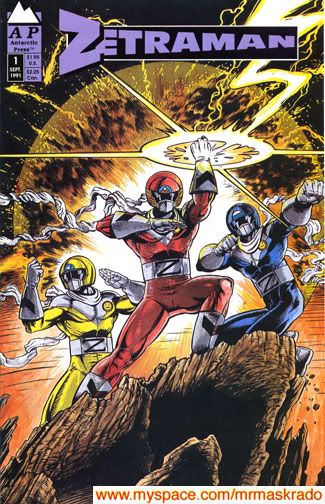
In "Venus Needs Men," female invaders from Venus have their sights set on Zetraman's Zetra-powered genetic material.
But when the boys discover that repopulating a planet is not the fun-filled adventure they thought it would be, they fight for their freedom the Zetra Way: with lots of martial arts, and giant robot action.
The first miniseries introduced two Zetra Women:
ALEKA (aka Zetra Green):
Green-haired, former Venusian officer, brilliant strategist,
"the fish out of water"; powers unspecified
TERRI (aka Zetra Pink):
Strawberry blonde, former police officer, the most mature
member of the team, "the den mother"; powers unspecified
The miniseries was successful, even though it was by an unknown writer-artist team.
The good news was that we had beat the American debut of the Mighty Morphin' Power Rangers by almost a year.
The bad news was that our parody came out before most readers would "get" what we were parodying.
(Be that as it may, they liked it anyway: it stood on its own merits.)
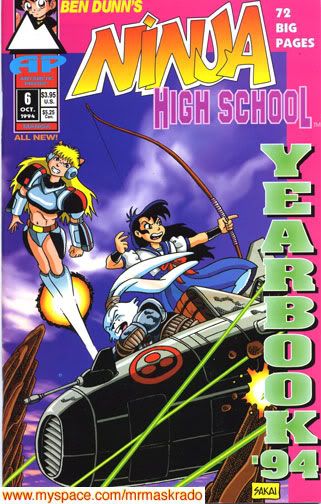
(Cover art by Usagi Yojimbo creator Stan Sakai.)
Antarctic Press publishes an annual Ninja High School Yearbook, which allows fans and pros to contribute short stories based on Ben Dunn's characters.
The 1994 Yearbook featured a 12-page Zetraman story by Yours Truly entitled "Caspia: The Very Friendly Ghost."
Zetraman: Revival! was the second Zetraman miniseries. It consisted of three issues.
When Professor Steamhead, one of the teachers from the regular Ninja High School series, gave the Zetra people their powers, he mixed the radiation from an ultra-rare element called Zetranite with steam.
After the initial treatment, all it took was a strong gust of steam (usually from their gimmicky Zetra Watches) to trigger the transformation into Zetraman. (Thus, "Steam on!")
When the Zetraman: Revival! miniseries begins, Mikey, Howard, and Phrank had lost their Zetra powers while battling giant monsters in Ninja High School #35.
A new source of Zetranite has been found that could revive the boys' powers, but it's in the possession of rival (and evil) Steamanologist, who plans to create a rival team: Zetra Force.
Zetraman: Revival! also introduces yet another Zetra character:
COLEN (aka Zetra Black):
Purple-haired (dyed brown to "fit in"),
rebel leader from the villain's homeworld,
the best Zetra fighter, "the loner";
aside from enhanced strength,
she doesn't need special powers
The Zetra Women do most of the fighting in the first couple of issues.
The last couple of pages of Zetraman: Revival! have the team watching--and complaining about--Fox TV's bastardized version of their "true" story (the Power Rangers).
Although Ben and I were inspired by the shows that the Power Rangers' producers had licensed from Japan, we remain convinced that they "borrowed" some of our ideas for their Americanized version.
(We were just slightly ahead of our time.)
Zetraman: Revival! was far more ambitious than the first miniseries, with a larger cast and a complex plot.
I would love to see a Special Edition someday, with revised scripts, re-drawn and decompressed art, and modern computer coloring.
Eternity Comics reprinted early, black-and-white issues of Ninja High School in color.
The first Zetraman miniseries is technically outside of regular Ninja High School continuity, but Ben Dunn liked it so much that he incorporated it into the color series' 12-issue run.
Terri/Zetra Pink never actually uses the Zetra Nunchucks in this issue, but I think they're a neat idea!
Around the time that the final color issue issue was published, Ninja High School returned to Antarctic Press, after a long run with Eternity Comics.
In 2006, Ninja High School celebrated its 20th anniversary.
It's one of the longest-running independent comics, and one of the first to incorporate manga and anime style, and Japanese storytelling techniques.
The Cheerleader Commandos were the stars of this reprint collection, but it also contains my "Three Zetramen and a Baby" story (NHS #27).
The Ninja High School Textbooks are fat, phone book-sized tomes that collect all of the early issues.
This one (above) also includes my Zetraman story from #27.
Once again, NHS #27 is reprinted; this time in an inexpensive, pocket-sized format.
(And it's still in print!)
This beautiful example of early CGI was by Zetraman: Revival! artist Danny Fahs. It was supposed to be the cover for the third issue, but somebody got their wires crossed.
(A running joke is that the Zetra Robo always gets demolished at the end of every adventure, so they're constantly getting a new, improved model; not unlike the Starship Enterprise from the "Star Trek" films, or Kenny from "South Park.")
Finally, for your coloring pleasure:
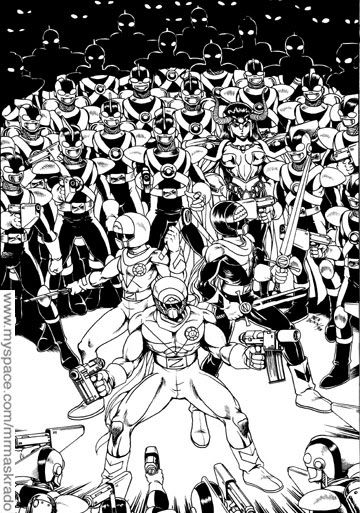
(Ben Dunn's original black-and-white cover artwork from Ninja High School in Color #09)
Over the last few years, Zetraman--as a team, and the individual members-- have made Zetra-cameos in various Antarctic Press comics, but they haven't enjoyed a "big" adventure since Zetraman: Revival!
Will they "Steam On!" again?
That's up to Ben Dunn, and the readers.
I admit that I'm biased, but I think Zetraman deserves a second look...
And, perhaps, a second REVIVAL!
----------------------------------------Thanks to Ben Dunn and Antarctic Press for giving me carte blanche to reproduce their covers and artwork.
Ninja High School and related titles and characters are Copyright and Trademark Ben Dunn.
The artwork on the covers of Zetraman #01-#03 was by Greg Espinoza; the cover to Ninja High School Yearbook '94 was by Stan "Usagi Yojimbo" Sakai.
The Zetra Robo was rendered by Danny Fahs.
All other artwork was by Ben Dunn.
The sentai and Ultraman stuff are Copyright and TM their respective owners.


